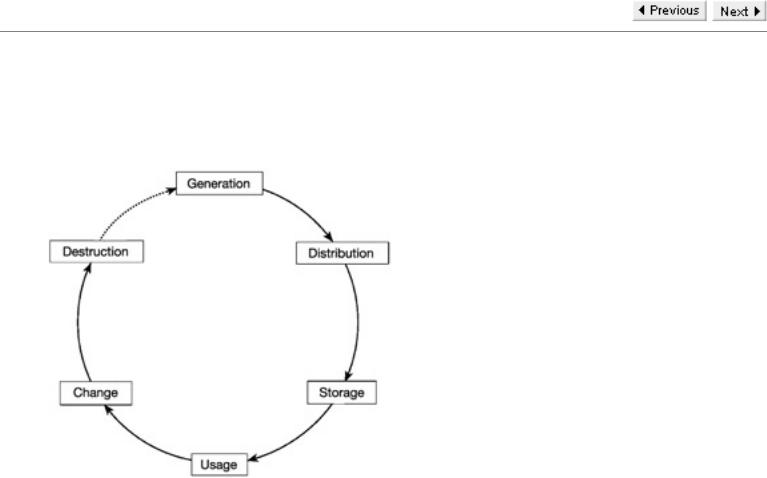
- •Table of Contents
- •BackCover
- •Cryptography-A Very Short Introduction
- •Chapter 1: Introduction
- •Using this book
- •Chapter 2: Understanding Cryptography
- •The basic concepts
- •Chapter 3: Historical Algorithms: Simple Examples
- •Caesar Cipher
- •Simple Substitution Ciphers
- •The statistics of the English language
- •The Playfair Cipher
- •Homophonic Coding
- •Polyalphabetic Ciphers
- •Vigenère Ciphers
- •Transposition Ciphers
- •Super-encryption
- •Some conclusions
- •Appendix
- •Chapter 4: Unbreakable Ciphers?
- •Perfect secrecy
- •The one-time pad
- •Chapter 5: Modern Algorithms
- •Bit-strings
- •Stream ciphers
- •Block ciphers (ECB mode)
- •Hash functions
- •Public key systems
- •Chapter 6: Practical Security
- •Realistic security
- •Practical exhaustive key searches
- •Attacks on public key systems
- •Chapter 7: Uses of Cryptography
- •Using symmetric algorithms for confidentiality
- •Authentication
- •Using symmetric algorithms for authentication and data integrity
- •Digital signatures
- •Certification authorities
- •Public Key Infrastructure
- •The need for trust
- •Chapter 8: Key Management
- •The key life cycle
- •Key hierarchies
- •Managing keys in networks
- •Using a trusted management centre
- •Key recovery and key back-up
- •Chapter 9: Cryptography in Everyday Life
- •A cash withdrawal from an ATM
- •Pretty Good Privacy (PGP)
- •Secure web browsing
- •Using a GSM mobile phone
- •References and further reading

Chapter 8: Key Management
Team-Fly
Chapter 8: Key Management
Introduction
In the earlier chapters, we concentrated on algorithms and their uses. However, we have repeatedly stressed the importance of good key management. In general, the effectiveness of cryptographic services depends on a number of factors that include the strength of the algorithm, a number of physical properties, including tamper-resistance of crucial hardware devices and access control to hardware, plus key management. Strong algorithms are used to prevent attackers calculating keys. However, their value is minimized if the attackers can obtain the appropriate keys by other means. The security of any cryptographic system is totally dependent on the security of the keys. The keys need protection during all phases of their life cycle. In this chapter we explain precisely what we mean by key management, look at the risks to which keys are likely to be exposed, and discuss some practical solutions. We often refer in this chapter to some of the more commonly adopted standards, notably those produced for the banking industry by the American National Standards Institute (ANSI). To be effective, a key management scheme needs to be carefully chosen to ensure that it meets the business needs and implementation requirements of the system. It must never be forgotten that overly elaborate cryptographic security systems represent a business overhead.
Team-Fly
file:///D|/1/4303/Fly0039.html [08.10.2007 12:51:21]

The key life cycle
Team-Fly
The key life cycle
The basic objective of key management is to maintain the secrecy and integrity of all keys at all times. For any given key this starts with the generation process and does not end until the key is no longer in use and has been destroyed. The main stages of a key's life cycle are shown in the diagram.
The key life cyclem
In almost all situations each key is eventually replaced by another. Thus the process is a cycle in the sense that key destruction is followed by its replacement by a new key. However, this new key is likely to have been generated, distributed, and stored before the old key is destroyed. In some systems, there may be an extra requirement for key archiving.
Monitoring procedures are needed throughout any key's life, to detect potential attacks on the key. This almost certainly involves some form of audit trail to log usages of the key, but there is obviously no point having this audit trail unless it is monitored. Furthermore, the value of monitoring is vastly reduced unless someone has the authority to act in response to a potential key compromise. Thus it is often desirable, especially in large systems, for keys to have designated owners who are responsible for their protection.
We now discuss each element of the life cycle. Although many of the basic management principles are the same, the management of keys for symmetric cryptography is very different from that required for keys for asymmetric cryptography. In fact the establishment of a PKI is essentially the basis of certain aspects of key management for asymmetric algorithms. In our discussion, we concentrate on symmetric systems and include occasional comments to indicate when the difference between the two systems is significant.
Key generation
Key generation is often a problem, especially for public key algorithms where the keys have complicated mathematical properties. For most symmetric algorithms, any string of bits (or occasionally other characters) is likely to be a key. This implies that most users of symmetric algorithms have the capability to generate their own keys. The main problem is to generate the keys in such a way that they are unpredictable. Popular methods include manual techniques (e.g. coin-tossing), derivation from personal data (e.g. PIN) or a (pseudo-) random number generator.
For asymmetric systems, the situation is different. The generation of large prime numbers requires some sophisticated mathematical processing and may require considerable resources. As discussed in the previous section, users may be forced to trust externally generated
keys or externally written software. If we consider RSA, its security relies on an attacker being able to factor the modulus N. If the key generation process gives only a limited number of primes, then the attacker could generate that limited number of primes and then try each prime as a factor. This is just one simple illustration of the importance of having good key generation for public key systems.
file:///D|/1/4303/Fly0040.html (1 von 5) [08.10.2007 12:51:22]

The key life cycle
Key distribution and key storage
Both key storage and the distribution of keys are very important. The problems encountered and the solutions implemented to solve them tend to be similar, and so we discuss them together.
The reason for using a strong algorithm is to prevent attackers from being able to calculate the key. This is a pointless exercise if attackers can find it in clear somewhere in the system. Secure storage of certain keys is almost certain to involve some form of physical protection. For example, keys might be stored only in locations to which physical access is tightly controlled. The protection of those keys would then be solely dependent on the effectiveness of the access control. Alternatively, keys might be stored on a device such as a smart card for which there are two levels of protection. First, the owners are responsible for ensuring that they maintain possession of the card. Secondly, the card might have a high level of tamper-resistance to prevent people who obtain it from reading its contents.
A crude rule for key protection is that, ideally, keys should not appear in clear anywhere in the system unless they have adequate physical protection. If that physical protection is not available, then the keys should either be encrypted using other keys or split into two or more components. This rule was introduced at a time when most encryption was performed in hardware. If feasible, it is still sound practice as tamper-resistant hardware storage is regarded as providing more protection than software. The concept of having keys protected by encryption using other keys leads to the concept of a key hierarchy, where each key is used to protect the one beneath it. Key hierarchies are important and we discuss them later in this chapter. However, for the moment we merely note that it is clearly not possible to arrange a system so that every key is protected by another and there must be a key at the top of the tree. This master key is likely to be generated and distributed in component form. The components are separately owned and are installed separately into the encryption device. Clearly, for the concept of using components to be meaningful, it should not be possible for anyone to gain access to all components in clear form.
We now consider how key components can be constructed that do not give any information about the key. Suppose that we wish to have two components that can be combined to construct a key K. The naive method would be to use the first half of K as the first component K1 and
the second half as the other component K2. However, knowledge of component K1 would enable the key K to be found merely by trying all possible values for the other component K2. So, for instance, if K were a 64-bit key then knowledge of K1 would mean that K could be determined in only 232 trials, needed to find K2, which is negligible when compared to the 264 trials needed for an exhaustive key search for K. A far better solution would be to generate two components K1 and K2 of the same size as K such that the key K is the XOR of K1 and K2 (K = K1 K2). Since K and K2 are the same size, knowledge of the component K1 does not lead to a faster method for finding the key K, as it is no easier to search for K2 than it is to search for K.
A more sophisticated approach is to use the concept of a secret sharing scheme. In this type of scenario there are a number of values, known as shares, and the key is obtained by combining some, or all, of them. One possibility might be, for instance, to have seven shares and design the system so that any four of those shares determine the key uniquely but knowledge of any three gives no information about the key. This not only introduces the security associated with shared responsibility but places less reliance on the availability of specific individuals if key recovery becomes necessary.
As with many other aspects of cryptography, key management for communication systems is considerably harder than for the handling of stored data. If a user is merely protecting their own information, then there may be no need for any distribution of keys. However, if there is a need to communicate securely, then there is often a need for key distribution. Furthermore, the magnitude of the associated problem is likely to depend upon the number of terminals that are trying to communicate securely. If there are only two such terminals, then this is referred to as a point-to-point environment. If there are more than two communicating terminals, then the solution to the key distribution problem is likely to depend both on the business application and the environment formed by the terminals. There are two extremes. One is the 'hub and spoke' environment, which consists of a central terminal (or hub) and a number of other terminals that must be able to communicate securely with the hub. The other is a 'many-to-many' environment that occurs where each terminal may require a secure link to every other.
For public key systems the situation is different. Much of this discussion applies to private keys as, like symmetric keys, they need to be kept
file:///D|/1/4303/Fly0040.html (2 von 5) [08.10.2007 12:51:22]
The key life cycle
secret. However, public keys are stored and distributed in certificates, as discussed in Chapter 7.
Key establishment
The idea of key establishment is that two parties have a method for agreeing upon a key between themselves. Such a method is called a key establishment protocol and is an alternative to distributing keys. It is, of course, crucial that the two parties are able to authenticate each other prior to establishing this key. The use of public key certificates makes this possible. The most well-known and widely used protocol of this type is due to Diffie and Hellman. In the Diffie-Hellman protocol, the two parties exchange their public keys. Using a carefully chosen combining rule, each party then combines their own private key with the other's public key. This gives them a common value from which the key is derived.
The need for the two users to be able to authenticate themselves is crucial. Without it, the protocol is subject to the so-called 'man-in-the- middle attack'. In this attack, an attacker intercepts communications between the two parties and then impersonates each party to the other. The result is that the two parties believe they have an agreed key with each other but, in fact, each party has agreed a key with the 'man in the middle'. This is a situation where digital certificates are invaluable.
The basic idea of the Diffie-Hellman key establishment protocol is that, even if they manage to eavesdrop on the key establishment communications, interceptors are not able to calculate the key. Quantum cryptography is an interesting new key establishment technique which does not rely on the strength of a cryptographic algorithm. The properties of quantum mechanics are used by the two parties for both the transmission of information and detection of interception of that transmission. The establishment of a key involves one user sending a random sequence to the other. If it is intercepted then that interception can be detected, and the establishment process is recommenced. A non-intercepted sequence is then used as the basis for the key.
Key usage
In many systems, each key has a prescribed usage and must be used for that purpose only. It is not clear that this requirement is always justified. However, there have undoubtedly been instances where weaknesses have resulted from multiple uses of single keys. It is now considered good practice to maintain separation of use.
We have already seen examples that demonstrate that the concept of using keys for only one purpose is a good idea. For example, we have already discussed the use of keys for encrypting other keys, which is regarded as distinct from encrypting data. In order to understand such a restriction of use in practice, we need to reintroduce the concept of a tamper-resistant security module (TRSM). If a user receives some ciphertext, then with this ciphertext and the appropriate key as input to the TRSM, the user expects the TRSM to output the data. However, if the user receives an encrypted key, then the user does not want the clear key as output from the module. Instead the user wants the key to be decrypted and used within the module. However, the ciphertext and the key are both bit-strings and the encryption algorithm cannot distinguish between them. Thus, the concept of key usage must relate to the functionality of the TRSM and not to the actual algorithm.
file:///D|/1/4303/Fly0040.html (3 von 5) [08.10.2007 12:51:22]

The key life cycle
Man in the middle
In order for keys to have unique usages, we need to assign a label to each individual key. This label specifies the key's use. For example, this label might specify a 'data encrypting key', 'key encrypting key', 'MAC generation key', or 'MAC verification'. Of course, the exact form of these labels depends on the TRSM and on the environment. For an asymmetric algorithm, users may need two public and private key pairs, one pair to be used for encryption and the other for signatures.
Once labels have been agreed, there must be a method of binding the label to the key so that adversaries cannot change the label and thereby misuse the key. One method is to let all encrypted versions of the key depend on the top-level key of the TRSM and the key's label. This ensures that the label could only be 'removed' within the TRSM. Once labels have been bound to keys, there has to be some mechanism for ensuring that keys cannot be misused. The design and configuration of the TRSM are crucial for enforcing this mechanism.
Key change
In all cryptographic systems, there must be the ability to change keys. There are many reasons for this, and changes may be either scheduled regular updates or responses to suspected compromise. If it is suspected that a key has been compromised, then it should probably be changed immediately. Many organizations have regular key changes as dummy runs so that they are prepared for an emergency and their staff have the relevant practical experience.
Keys are changed regularly to limit their exposure and reduce their value to an attacker. The value of a successful attack clearly determines the time and effort an attacker is likely to invest. There are EFTPOS (Electronic Funds Transfer at Point of Sale) systems where the key is changed after every single transaction. For such systems, an attacker is unlikely to invest large resources to launch an attack which yields only a single key and one compromised transaction.
There are no clear rules about how frequently keys should be changed. However, it is clear that every key should be changed long before it could be determined by an exhaustive key search. Another factor might be the perceived risks of the key being compromised balanced, on the other hand, by the risks associated with changing the key.
Key destruction
Keys must be destroyed in a secure manner whenever they are no longer needed. Thus, simply deleting a file that stores the key value is not sufficient. It is often desirable to provide meticulous detail of how it should be done. For instance, a relevant ANSI Standard states: 'Paperbased keying materials shall be destroyed by crosscut, shredding, burning or pulping. Key material stored on other media shall be destroyed so that it is impossible to recover by physical or electronic means.' In particular, this means that all electronically-stored keys should be positively overwritten on deletion, so that they do not leave a trace or other information that could be useful to an attacker. This is particularly important in software applications where the memory that is used to store keys may be used for some other purpose later on.
file:///D|/1/4303/Fly0040.html (4 von 5) [08.10.2007 12:51:22]

The key life cycle
Team-Fly
file:///D|/1/4303/Fly0040.html (5 von 5) [08.10.2007 12:51:22]
